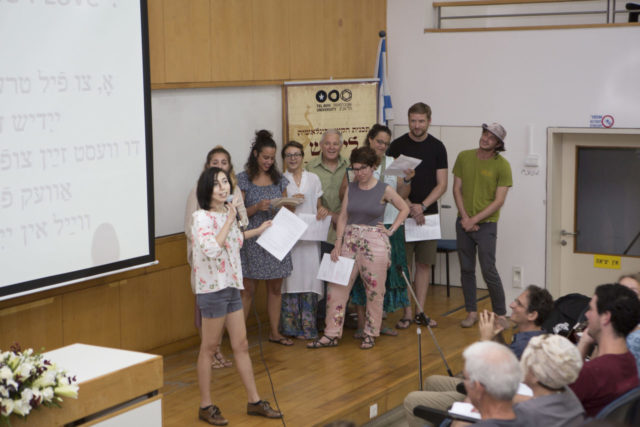The Doers for Yiddish


The Naomi Prawer Kadar International Yiddish Summer Program, directed by Professor Hana Wirth-Nesher, is conducted annually at Tel Aviv University. It brings together Yiddish enthusiasts from around the world for intensive instruction at five levels by internationally renowned professors.
The Naomi Foundation spoke with Raphael Halff and Miriam Schwartz – both master’s students in Yiddish Literature at Tel Aviv University – about their experiences with the 2019 summer program.
How would you describe your experience with the program?
Miriam (M): In one word, intense. It was like taking a vacation from my normal life and immersing myself in learning the language, meeting new people from all around the world, and seeing how they learn and research Yiddish. It was very interesting and really, really intense.
Raphael (R): The Naomi Kadar program has unique aspects. It focuses on Yiddish development in Israel and you get a very unique perspective on a completely different side of Yiddish. It feels very international, like you’re building connections. It has these permanent strings like in the detective office when they do that thing with yarn on the map.
M: Being exposed to Yiddish literature in an academic setting totally changed the way I think about Jewish writing. It made me aware of the many points of contact between Yiddish and Hebrew literatures, and gave me a new perspective about the way these literatures were evolving together at different points in history.
What were some highlights of the program for you?
M: Professor Justin Cammy’s classes on Yiddish literature was a real highlight. Every meeting was around one subject and you really go into a deep discussion about Yiddish literature. It made the experience more whole for me as a literature student. It felt whole and right.
R: I was struck by how everyone was actually doing something for Yiddish – Klezmer dance, research on new Yiddish contemporary film, making movies, writing. It was a very active group of people, people really doing things.
M: The program administrators were very supportive. It was very, very nice to have them taking care of the student needs. It felt very hamish and cozy, like home.
R: One day I had a picnic with the producer of Vaybertaytsh, a Yiddish feminist podcast. It was so very nice to sit and do what you would normally do – talk, sit, eat – but do it in Yiddish.
What new learning did you take away from the experience? How will you use the experience moving forward?
R: I learned the most from a full course on grammar. All we did was talk about this one specific grammar topic – it was almost too intense. If we submitted a story with five pages, the professor would give it back with his comments, which were triple the length of the story. It was so useful because we didn’t just learn from mistakes, you had this thing that you could carry around. It was incredibly valuable – I never sat through a course like that ever.
M: It was the first time I sat down to read a Yiddish literary text in a classroom, and it gave me the confidence I needed to move forward with my own research and to understand I can really read now. After that month I felt like I really jumped ahead and made significant changes in my abilities. At the end of the summer I took a qualifying exam in Yiddish and passed, and I’m now doing an advanced class. I wouldn’t have passed the exam without the summer program.
Why is it important for programs like this to exist?
R: I honestly think it’s programs like this that don’t let Yiddish die. It brings new people to Yiddish and allows the people who had perhaps a small interest to grow their interest until they become a part of the Yiddish group. The program creates audiences for Yiddish and activists – the doers for Yiddish.
M: As humanity students, a significant part of our course of study is acquiring language and studying it in a deep and meaningful way. This program introduces people to Yiddish literature and allows more people to choose Yiddish as their language of research. Programs like this can really bring new audiences to this culture and language and really beautiful literature, and hopefully help it survive for a long time.
R: If you were to graph the Yiddish revival that we’re currently going through – the number of theater productions, books, organizations, and scholarship – and then graph the growth of the Naomi Kadar program and other programs around the world, they would be totally in sync. I don’t think that’s just a correlation, I think it’s actually causation.